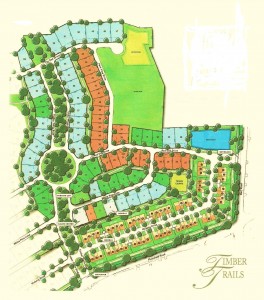The upscale Timber Trails subdivision comprises Western Springs’ only remaining vacant land. But, it has had a rocky road, to say the least.

Timber Trails – Phase I Plan
In 1833, Joseph Vial came to the Chicago area and first settled in Western Springs. He subsequently built a log cabin and staked claim to land north of Plainfield Road, just east of Flagg Creek. Over time, Vial’s landholdings, along with those of an in-law, stretched from what is now 55th Street to Plainfield Road and from Flagg Creek to Wolf Road, a total of 570 acres. Continuing in his father’s footsteps, Robert Vial became an accomplished farmer. In fact, he was one of the first in the area to ship milk to the Chicago market using the Burlington railroad.
In the mid-1920s, the entire country was becoming fascinated with the game of golf. As a result, the Vial family decided to convert some of their land into a golf course. Designed by Robert B. Harris, the 18-hole Timber Trails Golf Course was built between 1929 and 1930 and opened to the public in 1930. The Vial family retained ownership of the property until 1964 when it was sold to Roger Anderson, a land developer. Soon after, the golf course was re-designed to accommodate the construction of residential homes, including what is now the Ridgewood subdivision.
The golf course property encompassed the original Vial farmhouse, Robert Vial’s two-story brick home, a wooden picnic pavilion, a swimming pool (including a bathhouse and office), a golf starter shack, a clubhouse, and various maintenance buildings and garages. In 1989, Roger Anderson agreed to sell the original Vial house to the Flagg Creek Historical Society for one dollar, provided they would move the frame structure to Walker Park on Wolf Road. By all accounts, Roger Anderson enjoyed developing new homes, but he loved his golf course even more. However, in the early 1990s, he decided it was time to deed the property to his two adult children. And, while the club continued to operate as before, its days were numbered.
Shortly after Roger’s death, his children decided to sell the property. And, to make matters more interesting, the sale would be done by public auction. In 2004, the 104-acre property was sold for $45 million. Even before the sale, suggestions were made to develop the property to include an upscale retirement complex along with single-family residences. However, the new owners, Dartmoor Homes, decided that its new “Timber Trails” subdivision would contain both two-story luxury condominiums and higher-priced single-family homes. After much discussion and negotiation, the land was annexed by Western Springs.
Despite literally dozens of concessions by the new owners, nearby residents, as well as outside conservation groups, attempted to stop the development. These efforts included an unsuccessful attempt to convert the property into a Forest Preserve. When that failed, opponents filed numerous lawsuits and also raised environmental and tree conservation concerns which further delayed the development. Finally, by 2006, the first phase of the subdivision was starting to take shape with roads and quite a few homes and condominiums. But, by then, the bottom was falling out of the real estate market. In 2009, Dartmoor Homes had to file for bankruptcy.
Today, Timber Trails is under new ownership and home construction is once again underway. One can only wonder what Joseph Vial would think if he could see how his log cabin’s surroundings have changed over the past 180 years.
